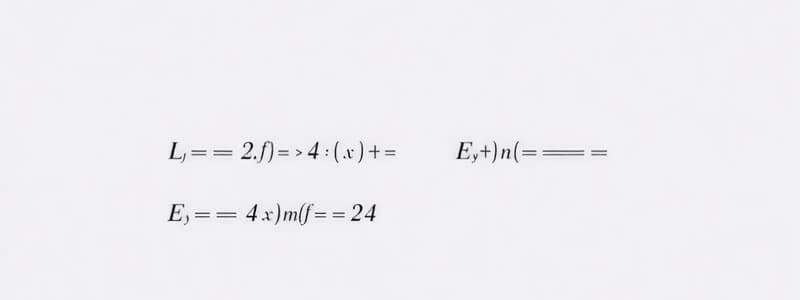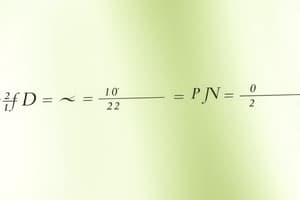Podcast
Questions and Answers
Wo werden Talgdrüsen gefunden?
Wo werden Talgdrüsen gefunden?
- In den Muskeln
- Im Gehirn
- Im Herzen
- In der Haut (correct)
Holokrine Sekretion bedeutet, dass die Zelle selbst zum Sekretionsprodukt wird.
Holokrine Sekretion bedeutet, dass die Zelle selbst zum Sekretionsprodukt wird.
True (A)
Was ist die Hauptfunktion von fettigem Sekret?
Was ist die Hauptfunktion von fettigem Sekret?
Einfettung der Hautoberfläche und des Haars
Ohrenschmalz (Cerumen) ist ein besonderes ______ der im äußeren Gehörgang vorkommt.
Ohrenschmalz (Cerumen) ist ein besonderes ______ der im äußeren Gehörgang vorkommt.
Wo wird die apokrine Sekretion gefunden?
Wo wird die apokrine Sekretion gefunden?
Schweißdrüsen produzieren immer öliges Sekret.
Schweißdrüsen produzieren immer öliges Sekret.
Welche Funktion hat Schweiß?
Welche Funktion hat Schweiß?
Spezifische Hautdrüsen dienen der Ansammlung von Drüsen an bestimmten ______ des Körpers.
Spezifische Hautdrüsen dienen der Ansammlung von Drüsen an bestimmten ______ des Körpers.
Welche Funktion haben Duftstoffe (Pheromone)?
Welche Funktion haben Duftstoffe (Pheromone)?
Milchdrüsen sind modifizierte Talgdrüsen.
Milchdrüsen sind modifizierte Talgdrüsen.
Was ist besonders an den Milchdrüsen bezüglich der Nervenversorgung?
Was ist besonders an den Milchdrüsen bezüglich der Nervenversorgung?
Nägel der Primaten und Hörner der Wiederkaüer sind aus ______ Zellen.
Nägel der Primaten und Hörner der Wiederkaüer sind aus ______ Zellen.
Woraus bestehen die Hörner der Wiederkaüer?
Woraus bestehen die Hörner der Wiederkaüer?
Hörner der Wiederkaüer wachsen nicht lebenslang.
Hörner der Wiederkaüer wachsen nicht lebenslang.
Nenne ein Beispiel für Horngbilde beim Geflügel.
Nenne ein Beispiel für Horngbilde beim Geflügel.
Vögel haben keine ______ in der Haut.
Vögel haben keine ______ in der Haut.
Welche Drüse schützt Vögel vor Feuchtigkeit?
Welche Drüse schützt Vögel vor Feuchtigkeit?
Federn dienen nicht dem Schutz vor Kälte.
Federn dienen nicht dem Schutz vor Kälte.
Was ist die Funktion der Färbung der Federn?
Was ist die Funktion der Färbung der Federn?
Der periodische Federwechsel wird als ______ bezeichnet.
Der periodische Federwechsel wird als ______ bezeichnet.
Welche Federart dient der Isolierung des Körpers?
Welche Federart dient der Isolierung des Körpers?
Fadenfedern sind nicht gut innerviert.
Fadenfedern sind nicht gut innerviert.
Wo befinden sich Borstenfedern?
Wo befinden sich Borstenfedern?
Tasthaare haben Kontakt mit ______.
Tasthaare haben Kontakt mit ______.
Wo befinden sich Tasthaare?
Wo befinden sich Tasthaare?
Ziegen haben keine Hautgebilde am Hals.
Ziegen haben keine Hautgebilde am Hals.
Was ist die Funktion der Wammen bei Rindern?
Was ist die Funktion der Wammen bei Rindern?
Hähne haben am Kopf Kamm und ______.
Hähne haben am Kopf Kamm und ______.
Woraus bestehen Zehenendorgane?
Woraus bestehen Zehenendorgane?
Zehenendorgane haben immer Drüsen oder Haare.
Zehenendorgane haben immer Drüsen oder Haare.
Nenne ein Beispiel eines Zehenendorgans bei Fleischfressern.
Nenne ein Beispiel eines Zehenendorgans bei Fleischfressern.
Die Hufepidermis der Equiden ist gleichbedeutend mit dem ______.
Die Hufepidermis der Equiden ist gleichbedeutend mit dem ______.
Welche der folgenden Strukturen gehört zur Wand des Hufs?
Welche der folgenden Strukturen gehört zur Wand des Hufs?
Das Wachstum des Hufhorns beträgt ca. 20mm pro Monat.
Das Wachstum des Hufhorns beträgt ca. 20mm pro Monat.
Nenne eine Umbildung des Ballens beim Pferd.
Nenne eine Umbildung des Ballens beim Pferd.
Die Haut unterstützt die ______ von Mineralstoffen und Stickstoffverbindungen.
Die Haut unterstützt die ______ von Mineralstoffen und Stickstoffverbindungen.
Welche Funktion hat die Haut?
Welche Funktion hat die Haut?
Die Haut nimmt keine Reize auf.
Die Haut nimmt keine Reize auf.
Welchen Einfluss hat UVB-Strahlung auf die Haut?
Welchen Einfluss hat UVB-Strahlung auf die Haut?
Die Unterhaut speichert Fett, Wasser und ______.
Die Unterhaut speichert Fett, Wasser und ______.
Welche Schicht bildet einen Verband in der Epidermis?
Welche Schicht bildet einen Verband in der Epidermis?
Die Lederhaut ist gefäßfrei.
Die Lederhaut ist gefäßfrei.
Welche Aufgabe haben die Haare?
Welche Aufgabe haben die Haare?
Die Haupttsubstanz der Haare ist ______.
Die Haupttsubstanz der Haare ist ______.
Ordne die folgenden Haarwachstumsphasen zu:
Ordne die folgenden Haarwachstumsphasen zu:
Durch was wird die Haarfarbe beeinflusst?
Durch was wird die Haarfarbe beeinflusst?
Haar und Hauptpigment müssen gleich sein.
Haar und Hauptpigment müssen gleich sein.
Was ist der Unterschied zwischen Dechhaar und Leithaaren?
Was ist der Unterschied zwischen Dechhaar und Leithaaren?
______ sind steife Dechhaare mit gespaltener Spitze.
______ sind steife Dechhaare mit gespaltener Spitze.
Die Haut dient als Barriere gegen die ______.
Die Haut dient als Barriere gegen die ______.
Welche der folgenden Drüsen ist eine modifizierte Schweißdrüse?
Welche der folgenden Drüsen ist eine modifizierte Schweißdrüse?
Vögel haben Schweißdrüsen.
Vögel haben Schweißdrüsen.
Wie heißt der periodische Federwechsel bei Vögeln?
Wie heißt der periodische Federwechsel bei Vögeln?
Ordne die folgenden Haararten ihrer Beschreibung zu:
Ordne die folgenden Haararten ihrer Beschreibung zu:
Flashcards
Holokrine Sekretion
Holokrine Sekretion
Zellen füllen sich mit Sekret, die Zelle löst sich auf.
Säckenartig
Säckenartig
Befindet sich um das Haar angeordnet
Fettiges Sekret
Fettiges Sekret
Einfettung von Hautoberfläche und Haar, macht geschmeidig und wasserabstoßend
Haarbalgdrüse
Haarbalgdrüse
Signup and view all the flashcards
Apokrine Sekretion
Apokrine Sekretion
Signup and view all the flashcards
Wässriges Sekret
Wässriges Sekret
Signup and view all the flashcards
Spezifische Hautdrüsen
Spezifische Hautdrüsen
Signup and view all the flashcards
Markierung
Markierung
Signup and view all the flashcards
Milchdrüsen
Milchdrüsen
Signup and view all the flashcards
Milchdrüsen
Milchdrüsen
Signup and view all the flashcards
Horn der Wiederkäuer
Horn der Wiederkäuer
Signup and view all the flashcards
Horngebilde beim Geflügel
Horngebilde beim Geflügel
Signup and view all the flashcards
Talddrüsen bei Vögel
Talddrüsen bei Vögel
Signup and view all the flashcards
Funktion der Federn
Funktion der Federn
Signup and view all the flashcards
Mauser
Mauser
Signup and view all the flashcards
Konturfedern
Konturfedern
Signup and view all the flashcards
Daunenfedern
Daunenfedern
Signup and view all the flashcards
Fadenfedern
Fadenfedern
Signup and view all the flashcards
Borstenfedern
Borstenfedern
Signup and view all the flashcards
Ziegen
Ziegen
Signup and view all the flashcards
Rinder
Rinder
Signup and view all the flashcards
Hühner
Hühner
Signup and view all the flashcards
Zehenendorgane
Zehenendorgane
Signup and view all the flashcards
Hufe der Equiden
Hufe der Equiden
Signup and view all the flashcards
Hufepidermis
Hufepidermis
Signup and view all the flashcards
Wand des Hufs
Wand des Hufs
Signup and view all the flashcards
Sporn und Kastanie
Sporn und Kastanie
Signup and view all the flashcards
Schutz und Stützfunktion der Haut
Schutz und Stützfunktion der Haut
Signup and view all the flashcards
Unterstützung der Exkretion
Unterstützung der Exkretion
Signup and view all the flashcards
Sinnesorgan Haut
Sinnesorgan Haut
Signup and view all the flashcards
Mechanorezeptoren Haut
Mechanorezeptoren Haut
Signup and view all the flashcards
freie Nervenendigungen
freie Nervenendigungen
Signup and view all the flashcards
Temperaturregulation der Haut
Temperaturregulation der Haut
Signup and view all the flashcards
Vitaminsynthese der Haut
Vitaminsynthese der Haut
Signup and view all the flashcards
Speicherfunktion der Haut
Speicherfunktion der Haut
Signup and view all the flashcards
Atmung der Haut
Atmung der Haut
Signup and view all the flashcards
Epidermis
Epidermis
Signup and view all the flashcards
Basalschicht
Basalschicht
Signup and view all the flashcards
Hornschicht
Hornschicht
Signup and view all the flashcards
Melanozyten
Melanozyten
Signup and view all the flashcards
Lederhaut
Lederhaut
Signup and view all the flashcards
Lederhaut
Lederhaut
Signup and view all the flashcards
Unterhaut
Unterhaut
Signup and view all the flashcards
Haarkleid
Haarkleid
Signup and view all the flashcards
Hauptsubstanz Haar
Hauptsubstanz Haar
Signup and view all the flashcards
Haarfärbung
Haarfärbung
Signup and view all the flashcards
Study Notes
Partial Differential Equations
- 2nd order linear PDEs in two independent variables have a general form: $Au_{xx} + 2Bu_{xy} + Cu_{yy} + Du_x + Eu_y + Fu = G$, where A, B, C, D, E, F, and G are functions of x and y.
- The discriminant is $\Delta = B^2 - AC$.
Classification Based on Discriminant
- Hyperbolic: $\Delta > 0$
- Parabolic: $\Delta = 0$
- Elliptic: $\Delta < 0$
Wave Equation Example
- For $u_{tt} = c^2 u_{xx}$, $A = c^2$, $B = 0$, $C = -1$, thus $\Delta = c^2 > 0$, classifying it as hyperbolic.
Heat Equation Example
- For $u_t = k u_{xx}$, $A = k$, $B = 0$, $C = 0$, thus $\Delta = 0$, classifying it as parabolic.
Laplace's Equation Example
- For $u_{xx} + u_{yy} = 0$, $A = 1$, $B = 0$, $C = 1$, thus $\Delta = -1 < 0$, classifying it as elliptic.
Well-Posedness Conditions
- Existence: A solution must exist.
- Uniqueness: The solution must be unique.
- Stability: The solution must depend continuously on initial/boundary data.
- A PDE is ill-posed if any of the above conditions are not met.
Common PDEs
- Wave Equation: $u_{tt} = c^2 u_{xx}$, describes vibrations and waves, where $c$ is the wave speed.
- Heat Equation: $u_t = k u_{xx}$, describes heat diffusion, $k$ is the thermal diffusivity.
- Laplace's Equation: $u_{xx} + u_{yy} = 0$ (2D), $u_{xx} + u_{yy} + u_{zz} = 0$ (3D), describes steady-state phenomena at equilibrium.
- Poisson's Equation: $u_{xx} + u_{yy} = f(x, y)$ (2D), a generalization of Laplace's equation.
Boundary Conditions Types
- Dirichlet: $u$ is specified on the boundary.
- Neumann: $\frac{\partial u}{\partial n}$ is specified on the boundary, where n is the normal direction.
- Robin: A linear combination of $u$ and $\frac{\partial u}{\partial n}$ is specified on the boundary.
Solution Methods
- Separation of Variables: Assume $u(x, t) = X(x)T(t)$, substitute into the PDE, separate variables, and solve the resulting ODEs.
- Fourier Transforms: Transform the PDE into Fourier space, solve the resulting equation, and inverse transform to obtain the solution.
- Numerical Methods: Such as Finite Difference Method and Finite Element Method are also used for solving PDEs.
Algorithmic Game Theory
- Game theory: The study of mathematical models of strategic interactions among rational agents, with applications in economics, political science, biology, and computer science.
Prisoner's Dilemma Example
- Two suspects are arrested and face a deal with potential outcomes summarized in a payoff matrix.
- Each suspect's dominant strategy is to confess, even though the outcome is not Pareto efficient.
Algorithmic Game Theory Definition
- Algorithmic game theory: Combines game theory and computer science, dealing with computational aspects like computing solution concepts and analyzing the complexity of games.
Nash Equilibrium
- Nash equilibrium: A set of strategies where no player benefits from changing their strategy, given others' strategies.
- Computing a Nash equilibrium: Polynomial time for two-player zero-sum games using linear programming, PPAD-complete for general games.
Mechanism Design
- Mechanism design: Designing mechanisms to achieve desired outcomes when participants have private information and act strategically.
Auctions Example
- Auctions: A mechanism design example where the goal is to allocate a good to the highest-valuing bidder while maximizing revenue for the seller.
Types of Auctions
- Sealed-bid auction: each bidder submits a bid without knowing the other bids
- First-price auction: the highest bidder wins and pays their bid
- Second-price auction: the highest bidder wins and pays the second-highest bid
Vickrey Auction
- Vickrey auction: A second-price sealed-bid auction where the highest bidder wins but pays the second-highest bid and is incentive compatible and efficient.
Physical Principles of Semiconductor Devices
Band Bending & Non-Equilibrium:
- HW 8 is due today.
- No lab this week. (Thanksgiving Recess)
Band Bending at equilibrium (Review):
- A charge transfer occurs to align the Fermi levels when two materials with different work functions are joined.
- The charge transfer results in a charge density near the junction, and an electric field (related to the slope of the band edges).
Metal-Semiconductor Junction Example (Review):
- Consider a metal and an n-type semiconductor brought into contact.
- Electrons flow from the semiconductor to the metal where $\phi_m > \phi_s$, creates a region depleted of electrons near the junction.
- The depletion region has a positive charge due to ionized donors.
Band Bending equations (Review):
\begin{align*} \frac{d\varepsilon}{dx} &= \frac{\rho(x)}{\varepsilon_s} \ \frac{d^2\psi}{dx^2} &= -\frac{\rho(x)}{\varepsilon_s} \ \varepsilon(x) &= -\frac{d\psi}{dx} \end{align*}
- $\psi$ is the electrostatic potential, and $\varepsilon_s$ is the permittivity of the semiconductor, and $\rho(x)$ is the charge density
Width of Depletion Region (Review):
- The depletion region, $W$, can be found by solving Poisson's equation with the appropriate boundary conditions.
$W = \sqrt{\frac{2\varepsilon_s}{qN_d}(V_{bi})}$
- Where $N_d$ is the donor concentration, $V_{bi}$ is the built-in potential
Non-Equilibrium Conditions:
- the Fermi level is no longer flat across the device when an external voltage is applied to the junction.
- The applied voltage changes the potential difference across the junction, and thus the width of the depletion region.
Forward Bias:
- applied on p-side of the p-n junction as a positive voltage reduces the potential barrier.
- This allows more current to flow across the junction, and the depletion region narrows.
Reverse Bias:
- A negative voltage is applied to the p-side to increase the potential barrier.
- reduces the current flow across the junction and The depletion region widens.
Quasi-Fermi Levels:
- Under non-equilibrium conditions, the Fermi level splits into two quasi-Fermi levels, one for the electrons ($F_n$) and one for the holes ($F_p$).
- Degree of non-equilibrium is indicated by separation between Quasi-Fermi levels.
- Back to equlibrium quasi-Fermi levels recombine
np product:
- We define $n_i^2$ as: $n_i^2 = n_o p_o = N_c N_v e^{-E_g/kT}$
- Under equilibrium conditions we know:
$n_o = N_c e^{-(E_c - E_f)/kT}$ $p_o = N_v e^{-(E_f - E_v)/kT}$
- Under non-equilibrium conditions:
$n = N_c e^{-(E_c - F_n)/kT}$ $p = N_v e^{-(F_p - E_v)/kT}$
np product (continued):
$np = N_c N_v e^{-(E_c - F_n)/kT} e^{-(F_p - E_v)/kT}$
- Since $E_g = E_c - E_v$, we can write:
$np = N_c N_v e^{-(E_g + F_p - F_n)/kT} $ $np = \underbrace{N_c N_v e^{-E_g/kT}}_{n_i^2} e^{(F_n - F_p)/kT} $ $np = n_i^2 e^{(F_n - F_p)/kT} $
Low-Level Injection:
- The condition where the injected minority carrier concentration is much smaller than the majority carrier concentration. e.g. n-type semiconductor under low-level injection: $\delta p ## Heat equation
Definition
- Let $u(x,t)$ be the temperature of a bar at position $x$ and time $t$.
- Heat equation is: $\frac{\partial u}{\partial t} = k\frac{\partial^2 u}{\partial x^2}$, where $k$ is the thermal diffusivity.
Physical interpretation
- Describes how temperature changes over time in a given region.
- The rate of change of temperature at a point is proportional to the second spatial derivative of the temperature
Boundary conditions
- Dirichlet boundary condition: $u(0,t) = T_1$ and $u(L,t) = T_2$
- Neumann boundary condition: $\frac{\partial u}{\partial x}(0,t) = 0$ and $\frac{\partial u}{\partial x}(L,t) = 0$
Initial condition
- $u(x,0) = f(x)$
Solution
- Using separation of variables, we assume that $u(x,t) = X(x)T(t)$.
- Substituting into the heat equation, we get: $X(x)T'(t) = kX''(x)T(t)$
- Dividing both sides by $X(x)T(t)$, we get: $\frac{T'(t)}{kT(t)} = \frac{X''(x)}{X(x)} = -\lambda$
- Where $\lambda$ is a constant.
Ordinary Differential Equations
- $\qquad T'(t) = -k\lambda T(t)$
- $\qquad X''(x) = -\lambda X(x)$
Solving for $T(t)$
- $\qquad T(t) = Ae^{-k\lambda t}$
Solving for $X(x)$
$\qquad X''(x) = -\lambda X(x)$ The general solution is: $\qquad X(x) = B\cos(\sqrt{\lambda}x) + C\sin(\sqrt{\lambda}x)$
Applying boundary conditions
- Dirichlet boundary condition: $u(0,t) = 0$ and $u(L,t) = 0$ $\qquad X(0) = 0 \Rightarrow B = 0$ $\qquad X(L) = 0 \Rightarrow C\sin(\sqrt{\lambda}L) = 0$ $\qquad \sqrt{\lambda}L = n\pi$ $\qquad \lambda = \frac{n^2\pi^2}{L^2}$ $\qquad X(x) = C\sin(\frac{n\pi x}{L})$
- Neumann boundary condition: $\frac{\partial u}{\partial x}(0,t) = 0$ and $\frac{\partial u}{\partial x}(L,t) = 0$ $\qquad X'(0) = 0 \Rightarrow -B\sqrt{\lambda}\sin(0) + C\sqrt{\lambda}\cos(0) = 0 \Rightarrow C = 0$ $\qquad X'(L) = 0 \Rightarrow -B\sqrt{\lambda}\sin(\sqrt{\lambda}L) + C\sqrt{\lambda}\cos(\sqrt{\lambda}L) = 0$ $\qquad \sqrt{\lambda}L = n\pi$ $\qquad \lambda = \frac{n^2\pi^2}{L^2}$ $\qquad X(x) = B\cos(\frac{n\pi x}{L})$
General solution
- $\qquad u(x,t) = \sum_{n=1}^{\infty} A_n \sin(\frac{n\pi x}{L})e^{-k\frac{n^2\pi^2}{L^2}t}$
Applying initial condition
- $\qquad u(x,0) = f(x) = \sum_{n=1}^{\infty} A_n \sin(\frac{n\pi x}{L})$
- $\qquad A_n = \frac{2}{L}\int_0^L f(x)\sin(\frac{n\pi x}{L})dx$
The Laplace Distribution
Definition
- The Laplace distribution with location parameter $\mu$ and scale parameter $b > 0$ has the probability density function (pdf)
- $f(x) = \frac{1}{2b} \exp \left( -\frac{|x - \mu|}{b} \right)$.
Parameters
- Location: $\mu$
- Scale: $b$
Support
- The support of the Laplace distribution is $x \in (-\infty, \infty)$.
Mean
- The mean of the Laplace distribution is $E[X] = \mu$.
Variance
- The variance of the Laplace distribution is $Var[X] = 2b^2$.
Relation to Exponential Distribution
- If $X \sim \text{Laplace}(\mu, b)$, then $|X - \mu|$ follows an exponential distribution with rate parameter $\lambda = \frac{1}{b}$.
Applications
- Modeling data with heavier tails than the normal distribution.
- Bayesian inference:
- The Laplace distribution is the maximum entropy distribution for a random variable with a fixed first moment.
- Image processing: The Laplace distribution is used in image compression and denoising.
Generating Laplace Random Variables
To generate random variables from the Laplace distribution, you can use the following method:
- Generate $U$ from a uniform distribution on $(0, 1)$.
- Compute $X = \mu - b \cdot \text{sgn}(U - 0.5) \cdot \ln(1 - 2|U - 0.5|)$.
Studying That Suits You
Use AI to generate personalized quizzes and flashcards to suit your learning preferences.




